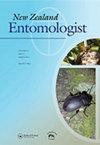一种以桃金娘锈Austropccuitia psidii为食的胆吸浆虫Mycodiplosis(Diptera:Cecidomyiidae)新种
IF 0.4
4区 农林科学
Q4 ENTOMOLOGY
引用次数: 0
摘要
摘要:在新西兰发现了一种未描述的胆吸浆虫幼虫,该幼虫以锈菌Austropccinia psidii为食,该锈菌感染了Lophomyrtus bullata、Lophomyratus obcordata和Syzygium jambos(均为桃金娘科)的叶子。该新种属于一个世界性的、以铁锈和霉菌为食的Mycodiplosis属(直翅目:Cecidomiiidae)。缩颈双孢霉的描述包括成虫、蛹和幼虫的形态,以及细胞色素氧化酶单元I线粒体基因片段的序列。这一新物种与同类物种的不同之处在于,它有一种不同寻常的aedeagus和一种特殊的雄性低足畸形。aedeagus顶部圆形,根尖下强烈收缩,具有根尖下刚毛感觉。前下叶长而窄,背面覆盖有长的顶端刚毛,腹面裸露,每个叶上有一对刚毛,其中一个位于顶端,另一个位于根尖下。目前已知的新物种的地理分布仅限于新西兰北岛。虽然新物种的幼虫可能会减少普氏冰藻的活脲虫数量,但新物种对作为生物控制剂和/或传播媒介的真菌宿主的种群动态的确切影响仍有待确定。http://zoobank.org/urn:lsid:zoobank.org:pub:3D39F717-49E0-4B46-9033-BE5A244D6A39本文章由计算机程序翻译,如有差异,请以英文原文为准。
A new species of Mycodiplosis gall midge (Diptera: Cecidomyiidae) feeding on myrtle rust Austropuccinia psidii
ABSTRACT Larvae of an undescribed gall midge were found feeding on the rust fungus Austropuccinia psidii that was infecting leaves of trees Lophomyrtus bullata, Lophomyrtus obcordata and Syzygium jambos (all Myrtaceae) in New Zealand. The new species belongs to a cosmopolitan, rust- and mildew-feeding genus Mycodiplosis (Diptera: Cecidomyiidae). The description of Mycodiplosis constricta sp. nov. includes morphology of adults, pupa and larva, and the sequence of a segment of the Cytochrome Oxidase unit I mitochondrial gene. The new species differs from its congeners in an unusual aedeagus and a peculiar male hypoproct. The aedeagus is rounded apically and strongly constricted subapically, bearing subapical setulose sensoria. The hypoproctal lobes are long and narrow, dorsally they are covered with long apical setulae, ventrally they are bare, each lobe bearing a pair of setae of which one is placed apically, the other subapically. The currently known geographical distribution of the new species is confined to the North Island of New Zealand. While it is likely that larvae of the new species decrease numbers of viable uredinia of Austropuccinia psidii, the exact impact of the new species on the population dynamics of the fungal host as a biological control agent and/or a transmission vector remain to be determined. http://zoobank.org/urn:lsid:zoobank.org:pub:3D39F717-49E0-4B46-9033-BE5A244D6A39
求助全文
通过发布文献求助,成功后即可免费获取论文全文。
去求助
来源期刊

New Zealand Entomologist
ENTOMOLOGY-
CiteScore
0.70
自引率
33.30%
发文量
3
审稿时长
>12 weeks
期刊介绍:
The invertebrate diversity of New Zealand is of great interest worldwide because of its geographic isolation and geological history. The New Zealand Entomologist plays an important role in disseminating information on field-based, experimental, and theoretical research.
The New Zealand Entomologist publishes original research papers, review papers and short communications. We welcome submissions in all aspects of science regarding insects and arthropods in a New Zealand or Australasian setting. The journal’s subject matter encompasses taxonomy, phylogenetics, biogeography, biological control and pest management, conservation, ecology and natural history.
The journal is the official publication of the Entomological Society of New Zealand. Papers published or submitted elsewhere for publication will not be considered, but publication of an abstract or summary elsewhere (e.g. conference proceedings) does not preclude full publication in the New Zealand Entomologist. Accepted papers become copyright of the Entomological Society of New Zealand. The journal is published in English, but we also welcome publication of abstracts in Maori.
 求助内容:
求助内容: 应助结果提醒方式:
应助结果提醒方式:


